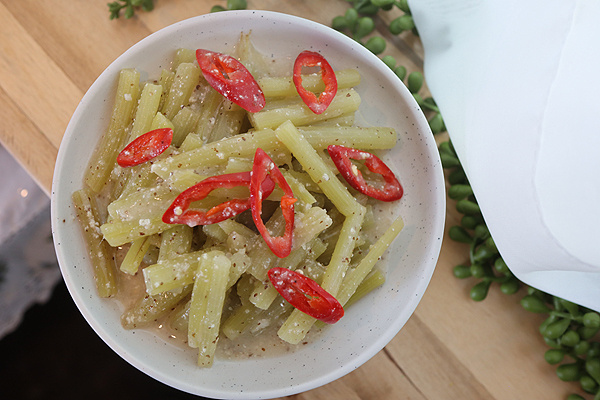Savory Perilla Seed Stir-fried Petasites Hybridus Stems
A Delicious Summer Side Dish Featuring Petasites Hybridus Stems Cooked with Perilla Seeds

This recipe introduces how to make a savory and delicious summer side dish using fresh Petasites hybridus (known as ‘Meowitdae’ in Korean) from your garden. While tender in early spring and enjoyed as wraps or namul, summer varieties can have a slight bitterness. However, by soaking them thoroughly in water and stir-frying with a perilla seed sauce, the bitterness disappears, leaving behind a rich, nutty flavor. It’s a fantastic side dish for rice and can even serve as a satisfying meal when chilled and enjoyed later.
**Tips for Success:**
– Proper soaking is key to removing any bitterness from summer Petasites hybridus.
– Pre-mixing the perilla seed sauce with water prevents clumping and ensures even distribution.
– Slow cooking over low heat allows the flavors to meld beautifully.
Ingredients- 1 bunch Petasites hybridus stems (Meowitdae)
- 1 cup water (for blanching)
- 2 Tbsp glutinous rice flour
- 1 Tbsp perilla seed powder
- 1 Tbsp soybean powder
- 1 Tbsp fermented rice salt (or regular salt)
- 50ml water (for sauce)
- 1/3 red chili pepper (for garnish and flavor)
Cooking Instructions
Step 1
Begin by preparing the Petasites hybridus stems. Remove the leaves and use only the stems. As you handle them, naturally occurring tough outer skins will also be removed.

Step 2
This step focuses on peeling the stems. Hold the end of a Petasites hybridus stem and pull downwards; the outer skin should peel away easily. Repeat this process to thoroughly remove all the skin.

Step 3
To remove bitterness and tenderize the stems, blanch them first. Place the peeled stems in boiling water and cook for about 5 minutes.

Step 4
Immediately after blanching, rinse the Petasites hybridus stems under cold running water to cool them down. This rinsing step helps to further reduce any remaining bitterness.

Step 5
Since summer Petasites hybridus can have a characteristic bitterness, it’s recommended to soak them in cold water for one to two days after peeling and blanching. To prevent spoilage during the summer, make sure to store them in the refrigerator while soaking.

Step 6
After two days, it’s time to stir-fry. Squeeze out excess water from the soaked stems. Place the prepared stems in a pan and add 1 cup of water. Cook over medium heat, stirring occasionally, as if stir-frying. This method helps to make the stems even more tender.

Step 7
While the stems are cooking, prepare the delicious perilla seed sauce. In a small bowl, combine 2 Tbsp glutinous rice flour, 1 Tbsp perilla seed powder, 1 Tbsp soybean powder, and 1 Tbsp fermented rice salt (or regular salt). Pour in 50ml of water and whisk until smooth, ensuring there are no lumps. Dissolving the sauce ingredients in water beforehand prevents clumping and ensures the sauce coats the stems evenly for maximum flavor.

Step 8
Once the Petasites hybridus stems are tender, pour in the prepared perilla seed sauce. Stir continuously over medium-low heat until the sauce thickens and coats the stems nicely. Cooking slowly allows the flavors to develop.

Step 9
While the sauce is reducing, prepare the red chili pepper. Wash 1/3 of a red chili pepper, remove the seeds, and slice it thinly on an angle. This adds a beautiful color and a hint of spice.

Step 10
When the perilla seed sauce has thickened and is well absorbed by the stems, turn off the heat. Stir in the prepared red chili pepper. Your flavorful and savory Petasites hybridus stem stir-fry, a perfect summer side dish, is now complete!

Step 11
Enjoy this freshly stir-fried dish with warm rice. Alternatively, chill it in the refrigerator for a refreshing summer side dish that can even be enjoyed as a healthy meal substitute. It’s a nutritious and satisfying option!




